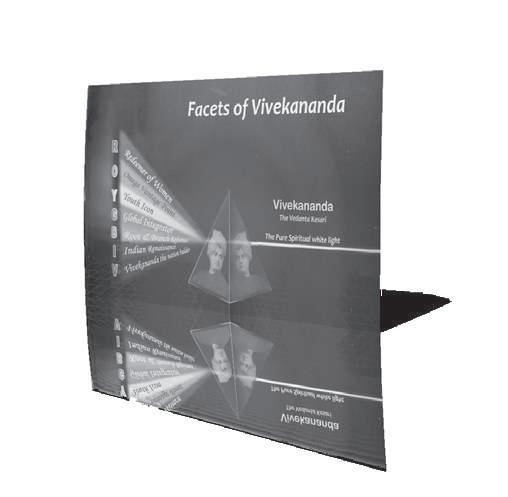
5 minute read
Book Reviews
Book Reviews Facets of Vivekananda 2015, artpaper, Rs.20 Science Universe Expansion in India.

Advertisement
2016, artpaper, Rs.20.
Both published by Ramakrishna Sarada Mission, Dakshineswar, Kolkata - 700 076. Booklets, published on the occasion of the 150 th birth anniversary celebration of Swami Vivekananda. T hese are two aesthetically illustrated books, the first being an exposition of
Swami Vivekananda and the second a book on Swamiji’s interest in science and technology as the means to take India forward.
Facets of Vivekananda has snippets showing Swamiji as a nation-builder through reform in all aspects of Indian society – religious belief, scientific temper, cultivation of the spirit of enquiry, attitudes towards women, and education – all of which combined to make him an icon of the youth of every generation. For example, he was unequivocal in his message that serving one’s fellow human beings, and not mere temple visiting, is true religious faith. Then again, he recommended autonomy for women, an unheardof concept in his times and not so widespread even today.
The second of the two books, Science Universe Expansion in India, traces Swamiji’s momentous meeting with Jamsetji Tata and their conversation which led to Mr. Tata’s investment in iron and steel and from there branching out into diverse fields which covered every aspect of India’s scientific future and established India as a fully self-sufficient nuclear power, using it in fields as varied as medicine and exploring Mars.
Both the books are bilingual in English and Bengali and the narration is short, crisp, and very readable. The production deserves special commendation. Printed on glossy art paper with apt illustrations, the books are a feast for the
For review in
The Vedant a Kesari, publishers need to send us two copies of their latest publication.
eyes, apart from being very good introductions to Swamiji’s amazing versatility. ____________________________PREMA RAGHUNATH, CHENNAI
Siva I am Siva I am
Published by Adi Shankara V e d a n t a P r a t i s h t a n a m , Plot No.1505, Mahatab R o a d , B h u b a n e s w a r , Orissa - 751 002. Email: adishankaravedantapratisthanam@gmail. com 2014, paperback, pp.133. Rs150. T he tone of this Shankara Jayanthi Volume 2014 book is set by the pithy title Siva I am Siva I am. The Editorial titled ‘I (Aham) (A Vedantic Analysis)’ discusses the problem of the ubiquitous eclipse of the Self by the Ego and offers solutions. There are in all 11 articles dealing with topics like Adi Sankara’s teachings, Prana Tattva in the Upanishads, Gaudapada and his Karika, significance of ‘Visvam’ as the first name in Vishnu Sahasranama, the universality of Dharma, and the essence of Sakta Siddhanta. Two texts Nirvanasatkam and Atmaanatma Viveka are interpreted in two articles. The latter text covers nearly half the book and presents two commentaries in Sanskrit.
The contents of all the articles are interconnected, as spokes to the nave, to the central theme of Advaita. The book can be called a bouquet of Advaitic blossoms. The heady
fragrance of the bouquet should be inhaled by one and all for their spiritual illumination. __________________________________ N.HARIHARAN, MADURAI
What The Buddha Taught by Walpola Rahula Published by Motilal Banarsidass Publishers Private Limited 41, U.A. Bungalow Road, Jawahar Nagar, Delhi - 110 007. 2017, paperback, pp.103. Rs.225. W alpola Rahula (1907-1997), a Sri Lankan Buddhist monk, scholar and writer became the Professor of History and Religions at Northwestern University, thus becoming the first bhikku to hold a professional chair in the Western world. Rahula wrote extensively about Theravada Buddhism.
What the Buddha Taught provides in eight chapters a succinct account of the teachings of the Buddha to a modern reader. It is based on the original, ancient Budddhistic texts from the Tibetan and Chinese translations in the absence of the original Sanskrit texts, which are lost.
According to Buddhism, there is nothing that is absolute in the world. Everything is relative, conditional and impermanent and there is no unchanging, everlasting absolute substance like Self, Soul, or Atman. What is known as ‘being’ or ‘individual’ is composed of Five Aggregates, the cause of ‘dukkha’ (suffering) - matter, sensation, perception, mental formations and consciousness which is based on the five senses. It is connected to the other faculties. There is no ‘Self’ or ‘Soul’ or ‘Ego’ opposed to matter. A Buddhist does not accept that consciousness is a sort of Self or Soul which is permanent. God is also denied by him.
Regarding rebirth, a Buddhist says that one’s energies do not die after one’s death but continue to take another shape. ‘Every moment, we are born and we die too,’ says a Budddhist.
The Buddha’s teachings can be practiced successfully even by a family man. There are hints dropped by the Buddha about how a family man must order his social, economic, and spiritual life.
The glossary of Pali words and index are of much help to the reader. This booklet is a concise and clear handbook of Buddhism. ______________________________ PANCHAPAGESAN, MUMBAI
Living Imprints of Indian Culture. by Swami Atmashraddhananda Published by Sri Ramakrishna Math, Mylapore, Chennai - 4. 2014, paperback, pp.102, Rs.30. L iving Imprints of Indian Culture is a compilation and analysis of twentytwo aspects of Indian culture. Aspects that feature in our everyday life yet whose true rationale we are most often not aware of. Rangoli to usher in auspiciousness is first described followed by a philosophical analysis of the term darshan. Namaste, the Indian form of welcome and Indian hospitality follow. Lighting of the lamp is part of the daily routine in every Indian home. Types of lamps used in various parts of the country are described.
Sacred marks on the body, bhajan and the beautiful custom of arati are detailed. Next comes the age old tradition of chanting of Vedas and sacred hymns. The concept of prasada and the vital role of Sanskrit as an integral part of Indian culture is defined as is the role of literature. The extensive tapestry of classical music, dance and folk music that form India’s artistic heritage is described.
The wide range of traditional Indian clothing and cuisine from various states of India is considered. The author touches upon the Silpa Sastra, Ayurveda and the contribution of Aryabhatta, the renowned Indian mathematician. The amazing story of Dara Shikoh, the Mughal prince who translated the upanishads into Persian is recounted.
This publication is a handy compilation of information which helps to understand popular customs and traditions and explains in a concise manner details that help us to appreciate our culture better. ______________________________ JAYANTHI VARMA, CHENNAI








